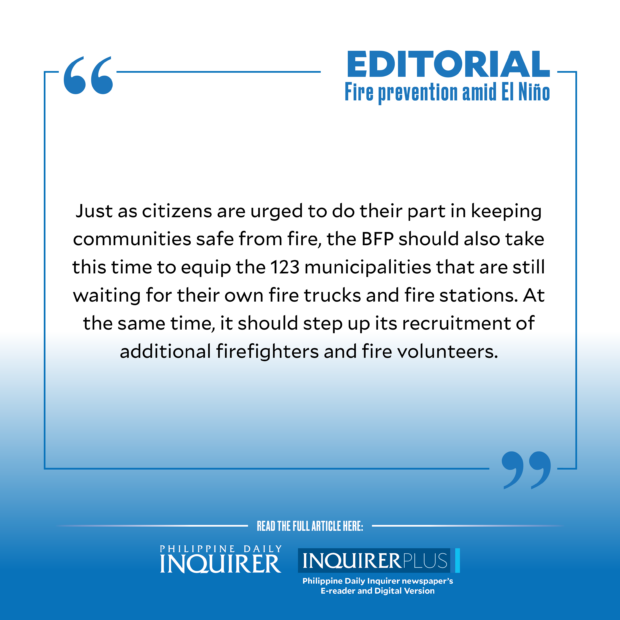
A series of fire incidents destroyed homes, property, and forest land across the Philippines in quick succession over the past few weeks, and these devastating events will likely increase amid dryer conditions brought about by the El Niño weather phenomenon.
The alarming prospect of more blazing fires gives added urgency and importance to the information drive and other awareness activities marking Fire Prevention Month this March with the theme “Sa Pag-iwas sa Sunog, Hindi ka Nag-iisa.”
The Bureau of Fire Protection (BFP) indeed took the occasion to call on the public to be more conscious than ever about fire safety as El Niño—marked by below average rainfall—will make surroundings dryer and easier to ignite and harder for firefighters to douse fires because of decreased water supply.
Common-sense safety behavior
This was already seen in the recent fires that devastated some 300 hectares of forest land in Baguio and Benguet. Local government authorities there blamed the fires on the prolonged dry season that made dry leaves more easily combustible.
The recent fires that rendered some 900 families homeless in the cities of Manila and Parañaque could also be partly blamed on the prevailing extra warm and dry conditions that can easily ignite blazes.
Preventing a repeat of these incidents will require vigilance and common-sense safety behavior, especially as fire incidents had surged even before the onset of El Niño.
BFP revealed last week when it launched Fire Prevention Month that the number of cases soared by 25.6 percent in the first two months to 3,044 from 2,424 cases in the same period last year.
Main culprits
The main culprits? Smoking or lighted cigarettes, unattended open flames from cooking, and electrical ignition, mostly in residential areas.
To think that fire incidents peak in March and April, a direct correlation to the increase in temperatures during the summer months.
“To sum up all these, we can say that the lack of consciousness of communities remain the main reasons for fire incidents. That’s why we emphasize awareness among communities in barangay levels,” said BFP spokesperson Col. Annalee Atienza.
Given this, all citizens must be extra careful when dealing with fire and electricity to save themselves and the greater community from fire, and the steps everyone needs to take are simple and easy to do and yet will go a long way in preventing fires.
‘Octopus’ connections
Personnel from the San Jose (Antique) Municipal Fire Station, for example, reminded residents in the community to conserve as well as store water that they can use in case fire breaks out in their home or their locale.
Smokers must also properly dispose cigarette butts as the smallest fire could be enough to ignite dried leaves and other combustible materials, which could then easily cause wildfires.
Good housekeeping also calls for unplugging appliances when not in use, avoiding “octopus” connections and overloading of electrical circuits, paying attention to open fires when cooking, and keeping lit candles away from flammable objects such as curtains.
Sources of fire must also be kept out of children’s reach, appliances should be installed properly and gas stoves must be checked for any leaks.
Fire safety tips
The Philippine Red Cross (PRC) came up with its own recommendations, urging every household to practice the four Ps (predict, plan, prepare, practice) to reduce the risk of fire in communities, particularly those with high densities that make them more vulnerable to fire.
These fire safety tips include not smoking in bed, extinguishing all live charcoal and embers after cooking in the kitchen and repairing any damaged sockets, switches, and defective electrical fixtures. All electrical installations, repairs, and changes should also be undertaken by licensed electricians, the PRC said.
Just as citizens are urged to do their part in keeping communities safe from fire, the BFP should also take this time to equip the 123 municipalities that are still waiting for their own fire trucks and fire stations. At the same time, it should step up its recruitment of additional firefighters and fire volunteers.
Modernization of the BFP
Chances are great that all municipalities will indeed have all the equipment and the personnel that they will need following the passage of Republic Act No. 11589, or the Bureau of Fire Protection Modernization Act, which provides for the enhancement of BFP’s capability to address fire-related emergencies starting this year.
“We are excited about the modernization of the BFP. In the next 10 years starting this year, we will be able to address the lack of fire trucks and fire stations as well as personnel,” said Atienza.
With added equipment and personnel plus adherence to basic fire safety tips, then Filipinos will have reason to look forward to fire incidents being minimized, not just this month and over the next few months amid El Niño, but ingrained as a way of life free from devastating fires.

